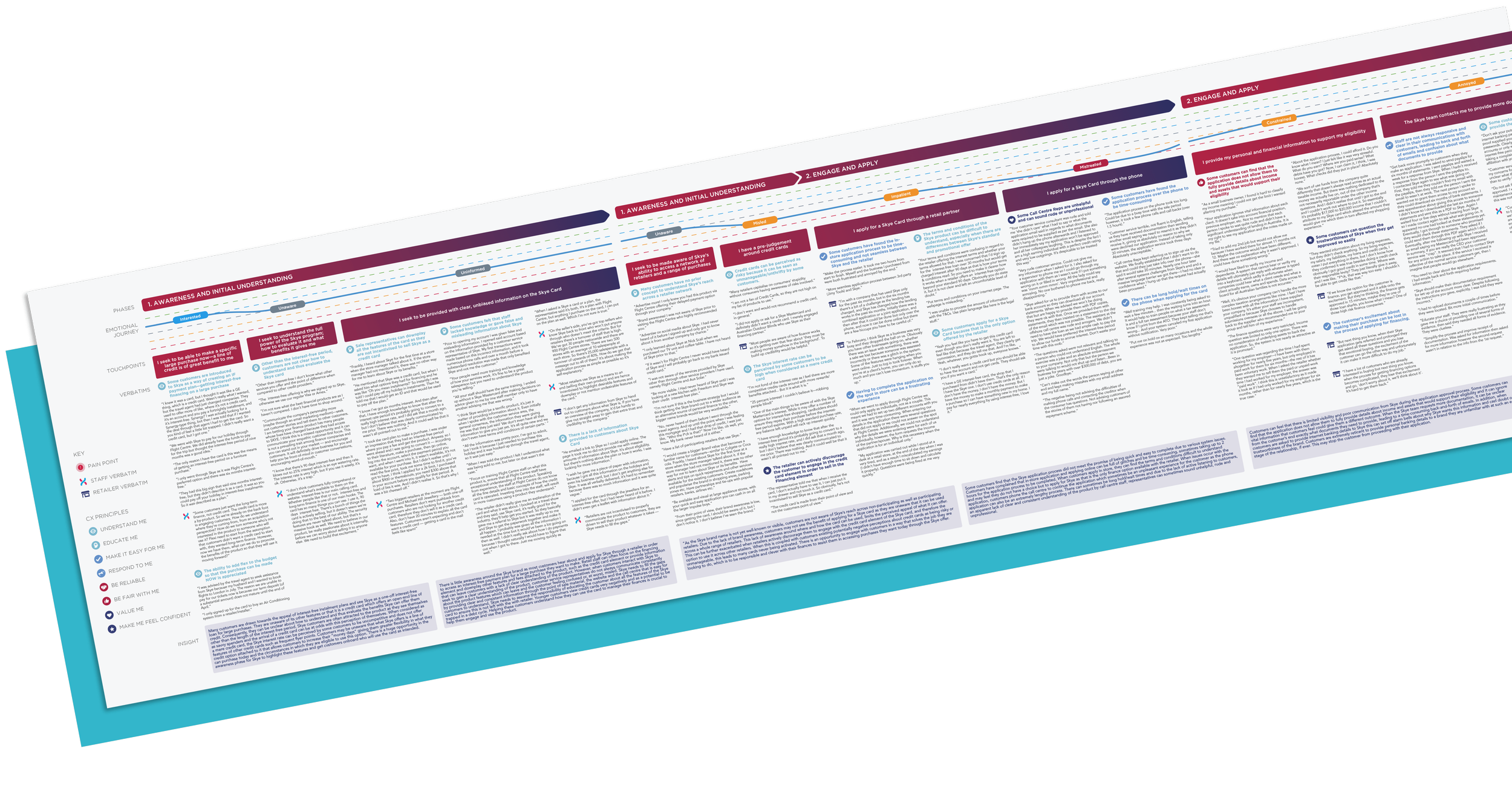
Customer Experience Journey Mapping That Drives Results
In today’s competitive landscape, customer experience journey mapping helps organisations uncover pain points, identify opportunities, and design journeys that customers truly value. Our approach goes beyond surface-level diagrams to deliver actionable insights that improve loyalty, reduce friction, and drive measurable business results. By aligning teams around the customer journey, we help organisations turn complexity into clarity and vision into execution.
We can help you understand and improve the customer experience journey, so every stage delivers value, builds loyalty, and drives measurable growth.
What we uncover
We uncover how customers actually move through your journey today.
Evidence-based mapping of each stage, channel, and touchpoint
Insights into customer needs, expectations, and pain points along the way
Clear view of the most critical gaps and opportunities for improvement
What we create
We create customer experience journeys that are simple, human, and commercially effective.
Visual journey frameworks that make the experience clear for your teams
Prioritised improvements that focus on the moments that matter most
Roadmaps that connect customer expectations with business outcomes
What it delivers
We help you turn customer journeys into a tool for measurable impact.
Step-by-step support to embed journey insights into daily decisions
ROI frameworks that prove the value of journey-based improvements
Governance tools to keep journeys updated and effective over time
Ready to make your customer journey work harder for your business?
Book a session with our team to uncover insights, redesign key moments, and deliver measurable results.
Areas of expertise
Customer Journey Mapping Templates
Build practical customer journey templates tailored to your organisation, ensuring consistency, clarity, and reusability across teams.
Managing the Customer Experience
Use journey maps as a foundation for managing customer experience, aligning strategy, operations, and delivery across your organisation.
Customer Journey Map Examples
Access proven customer journey map examples that show how leading brands translate insights into measurable growth and loyalty.
Customer Experience Consultants
Work directly with expert consultants who bring clarity, structure, and facilitation to your customer journey mapping projects.
Customer Experience Mapping Tools
Leverage the right customer experience mapping tools to capture insights, visualise journeys, and prioritise opportunities for improvement.

Why Invest in Customer Experience Journey Mapping
Customers expect seamless, consistent experiences across multiple channels. Without a structured customer journey map, businesses risk disjointed touchpoints, inefficiencies, and missed opportunities. Our journey mapping process brings clarity, helping you see your organisation from the customer’s perspective and prioritise improvements that matter most.
Customer Experience Journey Mapping That Delivers Results
We combine behavioural research, design thinking, and consulting expertise to create CX journey maps that reflect both customer needs and business goals. Whether you’re developing a template for repeat use or tackling a complex multi-channel experience, our consultants provide the frameworks, tools, and examples you need to embed journey mapping into daily operations.
Turning Insight Into Action
A journey map is only as valuable as the action it inspires. Our process ensures insights translate into service improvements, digital transformation projects, and cultural alignment across teams. With Proto, journey mapping isn’t a one-off exercise but a strategic capability that drives continuous growth and innovation.
Customer Experience Journey Mapping That Drives Results
Is your customer journey a journey your customers actually want to go on?
In today’s competitive market, customer experience journey mapping helps organisations uncover pain points, identify enablers, and design journeys that truly reflect customer needs. At Proto, our journey maps break down the steps your customers take when engaging with your service, offering not just insight but actionable solutions directly tied to measurable business outcomes.
Unlike surface-level diagrams, our customer journey maps establish a quantifiable link between CX initiatives and customer satisfaction. This allows you to see where investments will have the biggest impact — and where satisfaction scores can be lifted across the journey.
Your customers don’t think of you in terms of channels or functions. Whether they’re on your website, reading an email, phoning your support centre, or walking into your retail store, they’re interacting with your brand as a whole. Journey mapping offers a truly customer-centric approach to understanding these experiences, revealing both the enablers and obstacles they encounter at every stage.
Why Customer Journey Maps Are So Important
1. It Gives You the Customer’s Point of View
Customers don’t just buy and use products — they go through a series of interconnected stages. A customer experience journey map visualises these complexities, capturing what customers are thinking, feeling, and doing as they engage with your brand. Mapping key interactions over time provides clarity on how customers really move through your business.
2. It Reveals the Truth
Our journey maps are based on evidence and raw customer insight, not assumptions. This approach lets you uncover uncomfortable truths about where the experience breaks down. Facing this reality is the first step to creating experiences that genuinely delight.
3. It Identifies Obstacles — Which Are Opportunities
Every pain point is also an opportunity. A journey map highlights negative moments of truth caused by system, process, or service failures. By visualising the impact of these issues, you can prioritise fixes that will have the biggest influence on customer satisfaction and loyalty.
4. It Allows You to Empathise With Your Customers
At the heart of journey mapping are your customers’ emotions, motivations, and needs. By bringing the emotive side of the journey into focus, the exercise encourages teams across the organisation to see the world through the customer’s eyes. This shared empathy builds alignment and momentum for change.
Closing the Experience Gap
Most organisations today list customer experience as a strategic priority. Yet research shows a persistent gap between what businesses believe they deliver and what customers actually experience. One of the first steps to closing this gap is mapping the customer journey.
By visualising the journey end-to-end, organisations can:
Understand the true experience from the customer’s perspective.
Identify broken processes and high-impact opportunities.
Align cross-functional teams around the same evidence.
Build a roadmap for improving satisfaction and loyalty.
With Proto, journey mapping is more than a workshop. It’s a structured process that replaces guesswork with insight, reveals opportunities for innovation, and creates alignment across your organisation.















